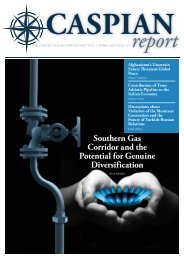Create successful ePaper yourself
Turn your PDF publications into a flip-book with our unique Google optimized e-Paper software.
MATTEO VERDA<br />
36<br />
traditionally accounts for the largest<br />
part of the market. In fact, distance<br />
from the producing countries and<br />
geographical features such as insularity<br />
or limited availability of local<br />
energy sources created the conditions<br />
for an early and massive development<br />
of the LNG technologies in<br />
the region. In 2013, Eastern Asian<br />
countries accounted for three quarters<br />
of the global LNG consumption.<br />
LNG TRADE REQUIRES SPECIAL TERMINALS FOR<br />
LIQUEFACTION AND REGASIFICATION PROCESSES.<br />
Three final markets in particular<br />
provided the bulk of demand: Japan,<br />
South Korea and China.<br />
The Japanese economy is heavily industrialised,<br />
with large primary energy<br />
consumption combined with a<br />
particularly small domestic production<br />
of energy. As a consequence, it<br />
relies on imported fossil fuels both<br />
for transport (oil) and power generation<br />
(mainly natural gas). In 2010,<br />
Japan imported 92 bcm of natural<br />
gas - 32% of the world total - exclusively<br />
via LNG. After the Fukushima<br />
Daiichi disaster, Japan substituted a<br />
significant share of its nuclear power<br />
generation with natural gas, increasing<br />
its dependence on LNG imports.<br />
Thus in 2013 Japan imported<br />
116 bcm, 37% of the world total.<br />
South Korea is similarly dependent<br />
on imported gas for power generation,<br />
and it is the second final market<br />
at the global level: it imported<br />
54 bcm of LNG in 2013, i.e. 17% of<br />
the world total. The third is China,<br />
which imported 54 bcm (9%). Unlike<br />
Japan and South Korea, the Chinese<br />
economy currently has a low<br />
level of dependence on imported energy,<br />
since it retains a large domestic<br />
production. However, its increasing<br />
final consumption and the need to<br />
reduce coal consumption in several<br />
polluted regions are driving a significant<br />
increase in natural gas imports,<br />
both via pipeline and LNG.<br />
Besides those three large consumers,<br />
other growing Eastern Asian economies<br />
represent a dynamic market for<br />
LNG. In particular, Taiwan is a relatively<br />
mature market, while India is<br />
set to become one of the most important<br />
players at the regional and<br />
global levels in the coming decades.<br />
Both countries imported 17 bcm<br />
each in 2013, i.e. slightly more than<br />
5% of the world total.<br />
Outside Eastern Asia, the most important<br />
LNG regional market is Europe.<br />
Demand in the region has been<br />
significantly reduced following the<br />
economic crisis and massive subsidies<br />
provided to renewable sources,<br />
which undermined final market for<br />
natural gas in the power generation<br />
sector. Moreover, the flexibility of<br />
LNG supplies allowed exporters to<br />
reroute their flows towards more<br />
dynamic markets after the onset of<br />
the current crisis. As a consequence,<br />
EU overall demand of LNG dropped<br />
from 80 bcm in 2011 to 39 in 2013,<br />
13% of the world total. Four countries<br />
constitute the EU core markets:<br />
Spain (12 bcm), the UK (9), France<br />
(8) and Italy (5). Germany, the main<br />
European gas market, has no regasification<br />
capacity, relying on piped<br />
gas from Russia and Norway. The<br />
only other relevant natural gas market<br />
in the region, Turkey, imported<br />
6 bcm via LNG in 2013, and was not<br />
affected by the EU’s economic crisis.<br />
Latin America is a smaller but more<br />
dynamic regional market. Overall, its<br />
consumption amounted to 25 bcm<br />
in 2013, with an annual growth of<br />
34% and a global share of 8%. Mexico<br />
is the largest importer (8 bcm),<br />
followed by Argentina (7), Brazil (6),<br />
and Chile (4). The increasing role<br />
of Latin America is driven by the










